In some ways Japan and South Korea might be at least partially to blame for the multiyear long obsession with masking in most of the Western world.
Many governments, especially in the United States, appeared to believe that the early “success” of countries on the Asian continent was due to a widespread cultural acceptance of masking.
That misguided assumption helped direct public health agencies, politicians, school boards and media outlets to shred dozens of high quality pre-Covid studies on masking and forcefully enact and enforce measures that were guaranteed to fail.
Once committed, they had no choice but to ignore the obvious global failure of masks and mask mandates and continue their disproven assertions that masks could end the pandemic in a matter of weeks or reduce infections dramatically.
We’ve since witnessed the anti-science crowd endlessly promoting masking and interventions, with the predictably disastrous results in the Western countries being waved off as a function of poor compliance.
“The reason it’s not working is because people aren’t complying with the mandates,” they’d say, contrary to overwhelmingly consistent survey data that measured mask usage in the 90-98% range across most of the United States and Europe.
To excuse their failure, anti-data activists would point to the Asian countries as “proof” that if we all just masked a little harder, we could bring Covid under control immediately.
Japan
Few aspects of Covid have been more consistent than the media’s love affair with Japan’s mask culture.
It’s been a repetitive theme. One survey found that 80% of Japanese people are likely to continue with masks after Covid-19 subsides.
And perhaps even more incredibly:
more than 90 percent of whom considered a face mask to be an asset rather than a burden, and feel comfortable with one on.
90 percent think of masks as an asset! Mind boggling isn’t it?
One website has gone so far as to create an etiquette guide for how to behave in Japan during the pandemic. This section explains that the expectation in Japan is for high-quality masking inside and outside:
You will be expected to wear a mask when indoors or on public transport, as well as in outdoor spaces where you encounter other people, such as in the streets and in urban parks.
For your mask to function correctly, ensure that your nose and mouth are covered and that there are no gaps. Various types of masks are used in Japan, but surgical masks made of non-woven fabric are the most common and recommended.
But it’s not just masking; you’re also expected to, and I cannot believe this is real, talk quietly.
“In restaurants, on public transportation and in other closed spaces, avoid talking in a loud voice, especially when not wearing a mask, e.g. during meals.”
Don’t speak in a loud voice? Who comes up with this nonsense?
You may not remember, but during the Summer Olympics hosted by Japan, cases in the country skyrocketed, leading to spectator-free games.
And just as with nearly everywhere else on earth, the surge peaked and dropped within a few months and reached extremely low levels.
Equally as unsurprising was the media rush to credit masks and vaccine rates with the dramatic decline, exemplified by an article from the Associated Press:
Almost overnight, Japan has become a stunning, and somewhat mysterious, coronavirus success story.
Some possible factors in Japan’s success include a belated but remarkably rapid vaccination campaign, an emptying out of many nightlife areas as fears spread during the recent surge in cases, a widespread practice, well before the pandemic, of wearing masks and bad weather in late August that kept people home.
Ah yes, the widespread practice of wearing masks. No mention of the statistical impossibility of masks causing the decline when they were worn before the surge started.
Obviously, given the percentage of people happily complying with masking, Japan must be a Covid-free paradise, right?
Let’s check!
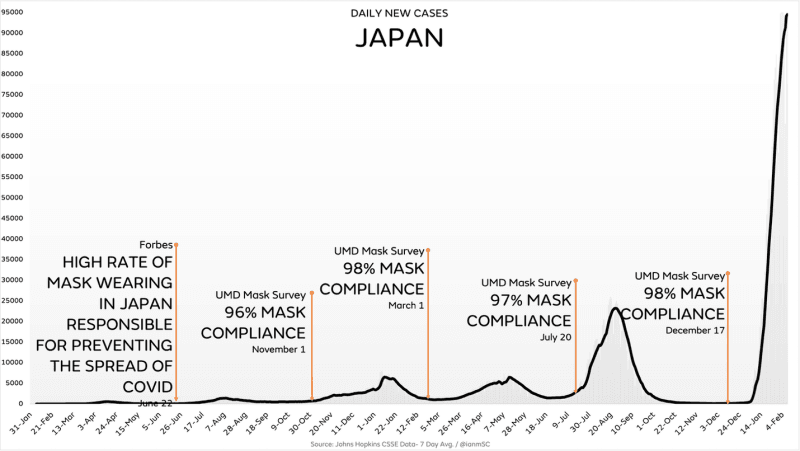

Oh no. That is not great.
When the story was published on October 18th, Japan was averaging 518 cases each day. By mid-February, that number was 94,491, an increase of 18,142%.
I wonder if there’ll be any new stories implying that masks don’t work because the curve went up over 18,000% a few months after they tried to credit mask wearing with bringing it down.
But that’s just one part of the story — Japan also has an exceptionally high vaccination rate, which, naturally, was mentioned as a possible explanation for the “bewildering” decline.
Many credit the vaccination campaign, especially among younger people, for bringing infections down. Nearly 70 percent of the population is fully vaccinated.
Well obviously that percentage has only increased over time, so let’s see how effective their high vaccination rate has been in preventing another surge:
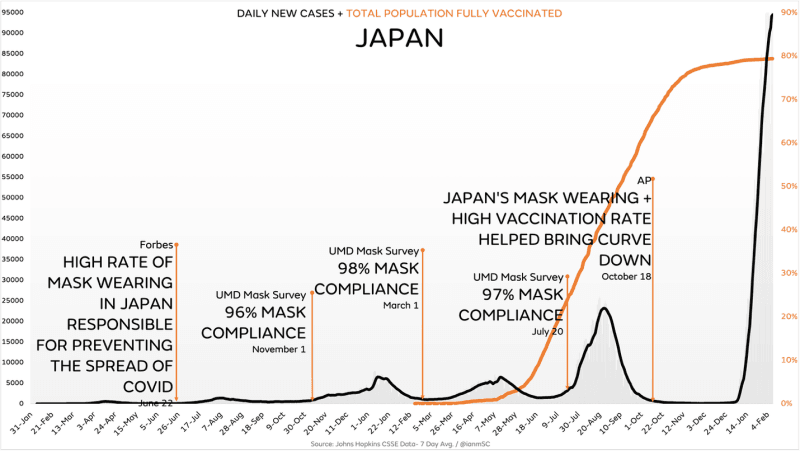

As always, the media completely ignores the impact of seasonal effects on Covid spread. One of the easiest ways to visualize this is by overlaying cases from year to year:
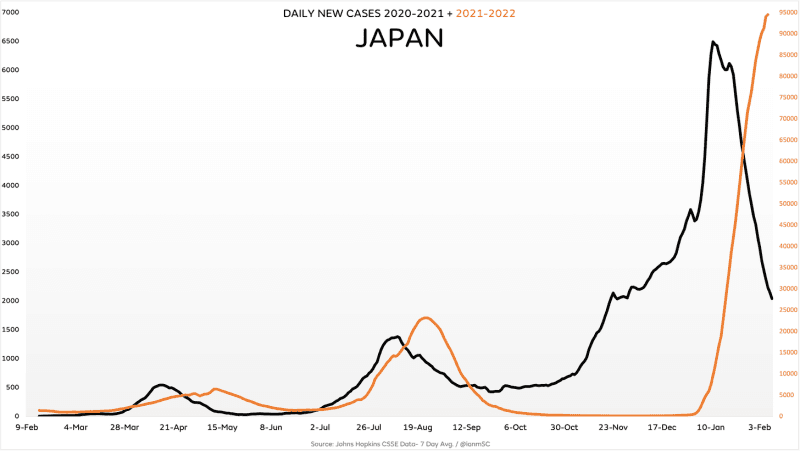

It’s important to note that numbers on each axis are vastly different to allow for better comparison, but it’s immediately obvious that increases and decreases have happened within weeks of each other — the 2021-2022 curve is essentially slightly delayed from 2020-2021. With that in mind, it’s clear that we would expect cases in Japan to peak in a matter of days.
And the top of the orange curve indicates that’s likely to happen, right on schedule.
This isn’t that complicated! The curve went down in October 2021 because it’s a period of low respiratory virus spread in Japan. Based on these numbers, we can expect that Japan’s curve might see another bump in late spring, followed by a more substantial surge in late summer, and a huge increase in the winter.
These surges have happened in predictable patterns, regardless of how dedicated they are to masks, regardless of how many people view masks as an “asset” and will continue wearing them for an endemic virus. And also despite the high vaccination rates that Japan has achieved.
Japan, despite their low testing, is even reporting similar rates to other countries that have unsuccessfully attempted to control Covid with masking:
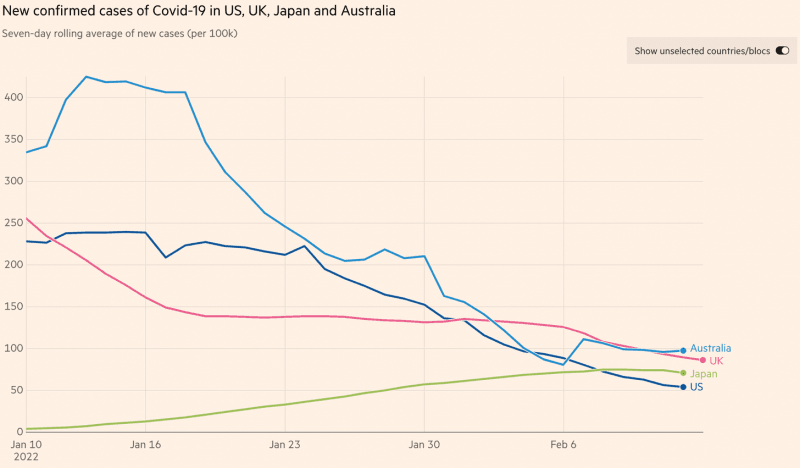

How does the media keep getting this wrong? How do they keep ignoring reality and maintaining an easily disproven narrative?
South Korea
It’s important to mention that the media does their best to credit other interventions, not just masks and vaccination rates, when attempting to explain the apparent success of Asian countries in combating the Coronavirus.
They also frequently praise the objectionable and nonsensical practice of “contact tracing.”
Just a few days after the AP’s missive about Japan, The Conversation published an article (don’t worry, they also credit masks) explaining that South Korea’s use of digital technology, contact tracing and quarantines to slow the spread of the coronavirus led to the country’s low case rates.
To combat Covid and future pandemics, governments need to heed the lessons of these social interventions and not just the technological ones. South Korea teaches us that high-tech solutions can help protect against disease, but these work together with social interventions – interventions that the UK has not used as effectively.
They continued:
Key to this has been quarantine measures for travelers arriving in the country, which were introduced very swiftly, and the country’s highly effective test-trace-isolate system. This carefully designed process provides local support for those in isolation, while monitoring them and sanctioning non-compliance.
Yes, mobile phone data and other forms of surveillance have been used to trace people who might have the virus. But once a positive case is confirmed, it is human intervention that ensures those people don’t spread the virus further.
There are several mind-blowing statements contained in these paragraphs, but my personal favorite is the hand-waving dismissal of “mobile phone data and other forms of surveillance” being used to trace Covid cases, as if that’s a totally normal and acceptable function of government that should be encouraged.
Allow me to submit a slight edit to their work:“We as a society need to eliminate any semblance of personal freedom and right to privacy in order to submit to the government’s desire to pretend they can control the spread of an endemic respiratory virus.”
Even if this worked, which we’ll soon see it most definitely does not, how can this be a remotely acceptable policy? How can anyone believe that this is a trade-off worth making? How can anyone think this technology will be discarded after Covid “ends,” whatever that means for an endemic virus?
As we’ve seen, governments and media have rapidly increased their calls for censorship — what’s to prevent them from using mobile phone surveillance to “isolate” those who share views they find “dangerous misinformation” until they can be rehabilitated into promoting “accurate” opinions?
None of this is remotely defensible ethically, but at least there could be a case made that it worked to help stop Covid — except The Conversation forgot about winter.
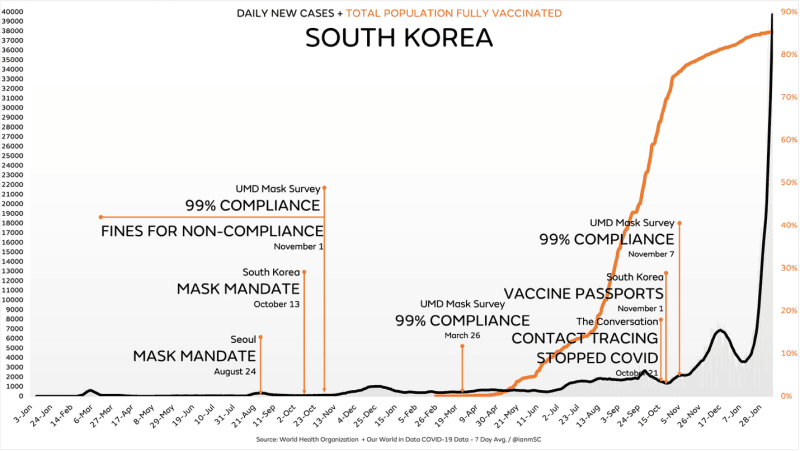

Cases have risen 2,800% since the article was published, despite South Korea’s dedication to testing, surveillance, isolation, mask mandates and vaccine passports.
How are we still pretending we can control Covid with layered interventions, with “Swiss Cheese Models of Pandemic Defense,” with following the example of Asian countries?
The collapse of Japan and South Korea’s pandemic response is yet another nail in the Covid mitigation coffin for those trying to credit masking and interventions with slowing or stopping the spread of a highly infectious respiratory virus.
For nearly two years now, we’ve seen media outlets attempt to allocate credit to interventions by ignoring the seasons. They purposefully wait until the curve goes down to report that masking in addition to their favored intervention of the week is responsible for controlling the surge — ignoring that the same interventions existed before the surge started.
South Korea and Japan have not had strict lockdowns, yet had better outcomes than most European or North American countries. However, it’s not due to masking or interventions, it’s likely been in large part due to cross exposure, as this study illustrates.
Yet that’s not a story the media wants to share, because they’ve fully committed to the indefinite pretense that human intervention is the most important factor in the spread of SARS-CoV-2.
Masks and interventions MUST work, because their preferred, trusted experts and politicians, say they do. Evidence and data be damned.
Well…maybe the pretense won’t be quite so indefinite.
I’m expecting my apology any day now.
Republished from Substack
Join the conversation:


Published under a Creative Commons Attribution 4.0 International License
For reprints, please set the canonical link back to the original Brownstone Institute Article and Author.









